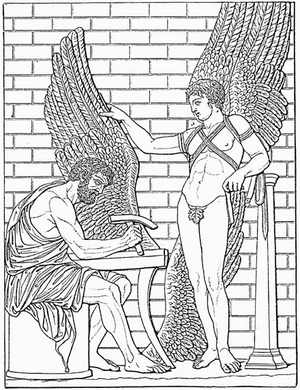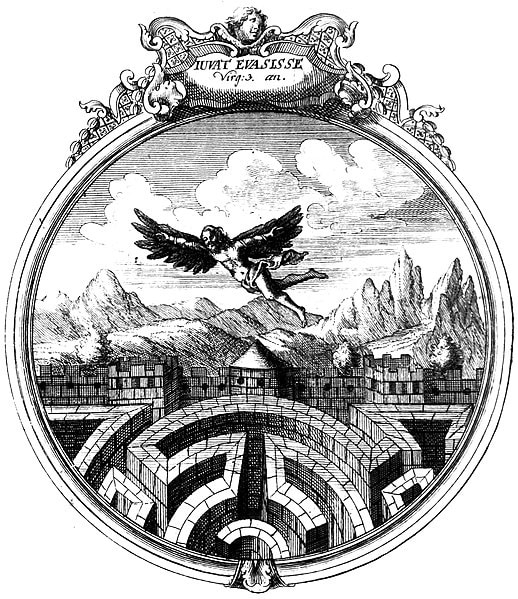The realm of Greek mythology is vast and intricate, much like the designs of Daedalus, the famed craftsman and architect. His tales, filled with innovation, ambition, and tragedy, have been a source of inspiration and caution for countless generations.
Daedalus Key Facts
| Parents | Metion and Alcippe |
| Partners | Naucrate |
| Siblings | None known |
| Offspring | Icarus and Iapyx |
| Other names | Daidalos |
| Roman name | Daedalus |
| Best Known Myth | The Labyrinth and Icarus’ flight |
Name and Etymology
The name “Daedalus” is believed to have roots in the ancient Greek term “daidalos,” which translates to “finely crafted.” It’s a fitting moniker for someone celebrated for his unparalleled craftsmanship. In Roman tales, he’s known by the same name, underscoring his universal appeal and recognition. Various epithets and titles have been ascribed to him over time, each emphasizing a different facet of his multifaceted persona.
Daedalus’ Roman counterpart shared his name, a rarity in the often distinct Greek and Roman mythologies. This shared nomenclature speaks volumes about his widespread fame and the universality of his tales.
While “Daedalus” is the most commonly recognized name, he’s also been referred to by other titles and epithets, each highlighting a unique aspect of his character or his deeds. These names serve as a testament to his multifaceted role in myths and legends.

Daedalus’ Family and Relationships
Born to Metion and Alcippe, Daedalus was destined for greatness from the start. His lineage, steeped in nobility, hinted at a life filled with privilege and learning. Yet, it was his own genius that would define his legacy.
His relationship with Naucrate bore him a son, Icarus, The Tragic Flight of Ambition. Their bond, as depicted in myths, is both heartwarming and tragic. The tale of Icarus’ ill-fated flight remains one of the most poignant stories associated with Daedalus, showcasing the duality of his genius and the unintended consequences of his inventions.
Beyond his familial ties, Daedalus’ interactions with monarchs, gods, and other figures from Greek mythology further paint a picture of a man whose brilliance was both a blessing and a curse.
Myths about Daedalus
Daedalus, with his unparalleled craftsmanship and ingenuity, is central to several myths that have both fascinated and served as cautionary tales for generations.
The Labyrinth and the Minotaur
King Minos of Crete, having a monstrous secret in the form of the Minotaur, sought the expertise of Daedalus. The Minotaur, Labyrinth’s Fearsome Inhabitant, a grotesque creature with the body of a man and the head of a bull, was the result of a curse and needed to be contained. Daedalus, with his unmatched architectural prowess, designed the Labyrinth, a maze so intricate that no one who entered could find their way out.
This marvel of design was not just a prison for the Minotaur but also a testament to Daedalus’ genius. However, the very creation meant to showcase his brilliance became a source of his woes. King Minos, to ensure the secret of the Labyrinth remained, imprisoned Daedalus and his son Icarus within its winding corridors, setting the stage for another iconic myth.
The Flight of Icarus
Trapped in the very maze he designed, Daedalus sought to escape the Labyrinth’s confines. His solution was as ingenious as it was daring: he decided to flee not by land, but by air. Crafting wings from feathers and wax for himself and Icarus, Daedalus envisioned a flight to freedom. As they embarked on their aerial escape, Daedalus warned Icarus not to fly too close to the sun or too near the sea.
However, the exhilaration of flight overcame Icarus. Drawn to the warmth of the sun and the thrill of soaring, he ignored his father’s warnings. As he ascended, the sun’s heat melted the wax on his wings, causing them to disintegrate. Icarus plummeted into the sea, meeting a tragic end. This tale, while highlighting Daedalus’ innovative spirit, also serves as a timeless reminder of the dangers of hubris and the consequences of not heeding wise counsel.
Depiction And Characteristics
In artistic renditions, Daedalus is often depicted as a thoughtful, mature man, tools in hand, symbolizing his craft. The wings, a poignant reminder of his aspirations and their tragic outcomes, are frequently associated with him.
His character, as gleaned from myths, is that of a brilliant mind, constantly pushing boundaries. Yet, his tales also serve as cautionary reminders of the potential pitfalls of unchecked ambition.

Representations Of Daedalus In Art
Daedalus, with his rich tapestry of tales, has been a muse for artists across ages. Ancient pottery often showcases him and Icarus, poised for their fateful flight. The Renaissance period, with its revival of classical themes, saw a resurgence in depictions of Daedalus, with artists capturing the intricacies of the Labyrinth or the tragic descent of Icarus.
Another notable representation is in sculptures, where the anguish of Daedalus, post Icarus’ fall, is palpably captured, serving as a somber reminder of the price of hubris.
Mentions in Ancient Texts
Homer, the legendary Greek poet from around the 8th century BC, subtly alludes to Daedalus in his epic, “The Iliad.” While not a central figure in this tale of the Trojan War, Daedalus’ reputation as a master craftsman is acknowledged. Homer’s mention, though brief, underscores Daedalus’ enduring legacy in the ancient world. The reference goes, “As when a man builds the high wall of a house with close-set blocks of stone to keep out forceful winds, so close their helms and bossed shields were set; shield pressed on shield, helm on helm, man on man.”
Another significant mention is in the works of Ovid, a Roman poet who lived from 43 BC to 17/18 AD. In his magnum opus, “Metamorphoses,” Ovid offers a detailed recounting of the tragic flight of Icarus. His portrayal is both vivid and emotional, capturing the essence of the father-son bond and the heart-wrenching consequences of youthful recklessness. A poignant excerpt from this text reads: “They passed Samos, Delos, and Lebynthos on the left and Calymne, Rhodes, and Helice on the right, when the boy began to delight in his daring flight, and deserting his guide, drawn by desire for the heavens, soared higher.”
Frequently Asked Questions
The Labyrinth, designed by Daedalus, was meant to imprison the Minotaur. It later became the setting for his and Icarus’ escape attempt.
Icarus, overcome by the thrill of flight, ignored his father’s warnings and flew too close to the sun. The wax on his wings melted, leading to his tragic fall.
While the Labyrinth and the wings are most iconic, Daedalus is credited with numerous other inventions and architectural wonders.
The grief of losing his son weighed heavily on Daedalus, but he managed to find refuge in Sicily under King Cocalus, escaping King Minos’ wrath.
While not directly punished, many of Daedalus’ innovations led to unintended consequences, often resulting in personal tragedies.
Featured Image Credit: Franz Xaver Wagenschön, Public domain, via Wikimedia Commons
